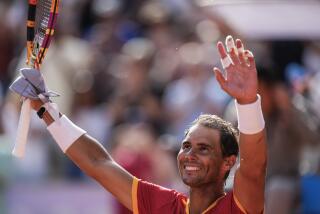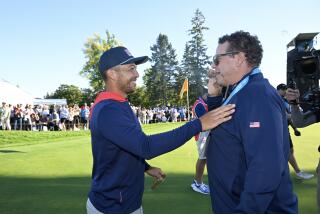Davis Cup : U.S. Doesn’t Get Worked Up Until It Loses Grip
- Share via
FT. MYERS, Fla. — It was once said of Davis Cup tennis competition that millions of people are passionately interested. It was also once said that, of that number, dozens come from the United States.
“In the United States, you have your World Series and Super Bowls,” said Francisco Gonzalez, a member of Paraguay’s Davis Cup team that will play the United States, here, starting today. “In Paraguay and other countries like it, the Davis Cup is that to us. It is everything.”
The United States has won more Davis Cup titles than any other country, 28. Yet the average sports fan probably thinks the Davis Cup is something Al gives out on Sunday afternoons to the game’s most valuable Raider.
If that’s an exaggeration, it’s only a slight one. Most people know the Davis Cup is tennis between countries, that the matches tend to go on forever and that a lot of them tend to be played in places that you get to by paddling your hollowed-out tree upstream.
So why do those who know it well hold it so dearly? Why does somebody such as John McEnroe get teary-eyed at the thought of it, or somebody such as Ken Flach get that faraway look in his eye, clench his fist and mutter that this is the real thing?
Michael Davies is the director of marketing for the International Tennis Federation, the organizing and sanctioning body of Davis Cup tennis. He is also a former Davis Cup player from Great Britain, who can speak both passionately and knowledgeably about it. “I had one of those magic moments myself,” Davies said Thursday. “I played Wimbledons and big tournaments, turned pro with Jack Kramer and his group in 1960. But that Davis Cup match, well, there’s just nothing like it.”
In 1957, Great Britain against France, the score tied, 2-2, Davies trailed Frenchman Robert Haillet by 2 sets. But he battled back to win, 8-6, in the fifth.
“It wasn’t even for the overall Davis Cup title, just a semifinal in the European zone,” Davies recalled. “But it was so special, to be down like that, on the slow clay at Roland Garros Stadium in Paris, and come back to win for your country.”
Ah, for your country. Perhaps that’s the key.
“Pat Cash can be playing somebody from Mexico in a key match at Wimbledon or the U.S. Open and most often he’ll win,” Davies said.
“But put him against that same Mexican, at 7,000 feet altitude in Mexico City, with the crowd wild for the home player, people waving flags and the surface the kind of slow clay the Mexicans love and you can throw out all the rankings and expectations in the world. You’ve got a close-to-even match.”
So, on the day that the United States begins its comeback effort in the main (World Group) draw after a couple of years of losing the struggles off in various jungles, not to mention Hartford, Conn., it is timely to take a look at just what the Davis Cup is. Much of the information and background provided here comes from Davies.
Question: Why is it called the Davis Cup?
Answer: Dwight Filley Davis, a tennis player at Harvard, donated a trophy that he designated to go to the winner of an international tennis competition. That was 1900, and the competition, with a few interruptions for wars, has gone on since.
Q: How many countries compete?
A: This year, a record 79 will compete.
Q: Is it true that the United States can win the Davis Cup this year, whereas, last year, it could not.
A: Yes. The United States was knocked out of what is called the World Group draw of 16 in 1987, when it lost at Paraguay and then lost at Hartford later in the year to West Germany. That meant that, just to get back into World Group draw in 1989, the United States had to beat Argentina and Peru last year. Only teams in the World Draw can win the Cup. The rest are playing just to get to the World Draw.
Q: Why is the United States playing Paraguay again?
A: Luck of the draw. The 16 teams making the World Group were tossed into a hat in October, and the United States pulled out Paraguay.
Q: Do they seed the draw after they make it?
A: Yes, this year’s World Group has Sweden, the 1987 champion, and West Germany, the ’88 winner, seeded to meet in the final. The United States is seeded third and would probably have to get past West Germany and Boris Becker in the semifinals in West Germany in late July to get to the title round.
Q: If the United States wins here, who’s next?
A: The winner here will go against the winner of the Israel-France match, either in Israel or against France in the United States, site to be determined, April 7-9.
Q: Why is this being played in Ft. Myers?
A: The resort here merely provided the right surroundings, seating capacity and financial guarantee to the United States Tennis Assn., which solicits bids immediately after the draw is made.
Q: What are the chances of a Davis Cup final coming to the Los Angeles area this year, assuming the team goes that far and has the home advantage for the final?
A: Probably slim, even though the final is scheduled for Dec. 15-17 and California is among the few warm-weather sites that time of year. Because there is a Grand Prix tournament at the Hyatt Grand Champions resort in the Palm Springs area a few months later, the Davis Cup people tend to take this sort of thing someplace else where fans haven’t had the opportunity to see top players. Nor do they hesitate to play it indoors.
Q: Do the players get any prize money out of this?
A: This year’s Davis Cup purse totals $3 million. Every country that competes will get a slice of that, but the more you win, the more your association gets and the more it distributes to the players. The only thing is, the distribution isn’t until the end of the year, when all the places have been decided. For example, Michael Chang will likely play just here for the American team, then be replaced by McEnroe. Chang will get his slice based on final standings and based on how many matches he played.
More to Read
Go beyond the scoreboard
Get the latest on L.A.'s teams in the daily Sports Report newsletter.
You may occasionally receive promotional content from the Los Angeles Times.











